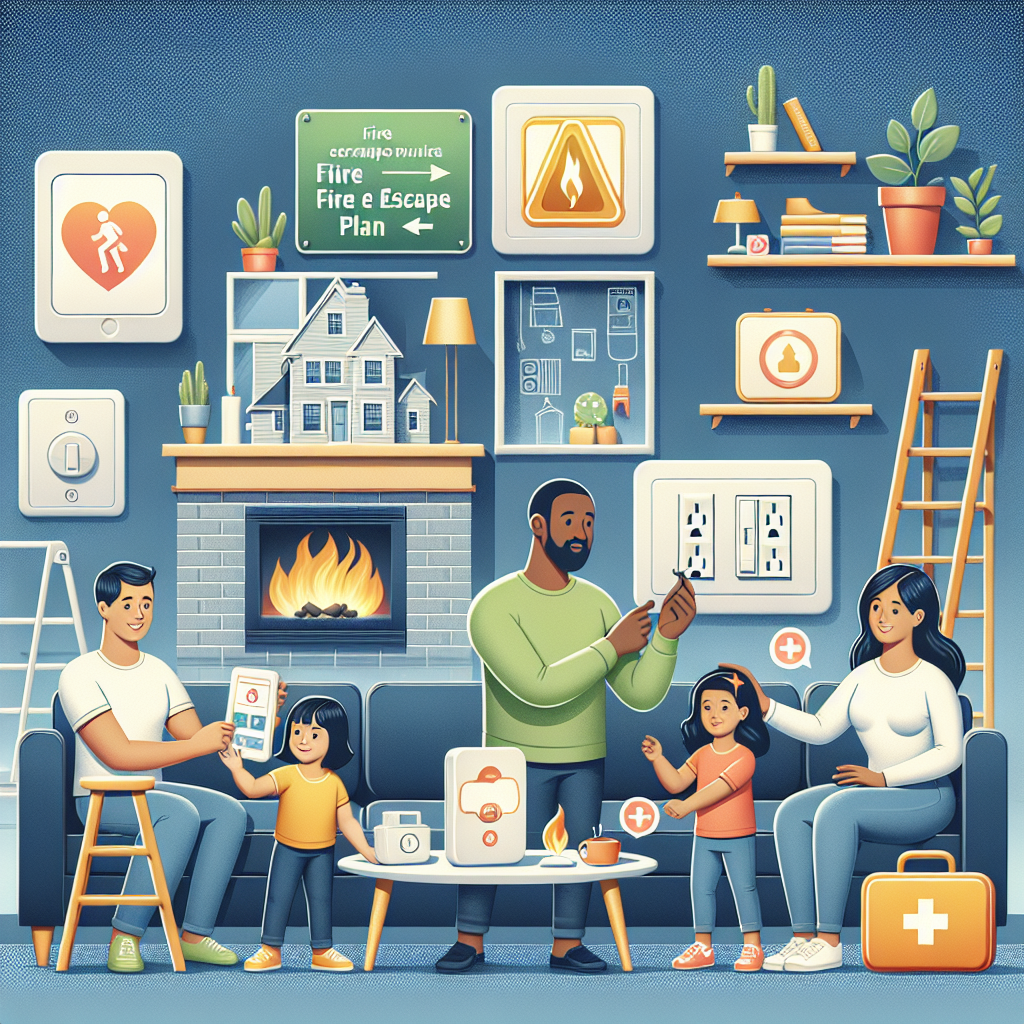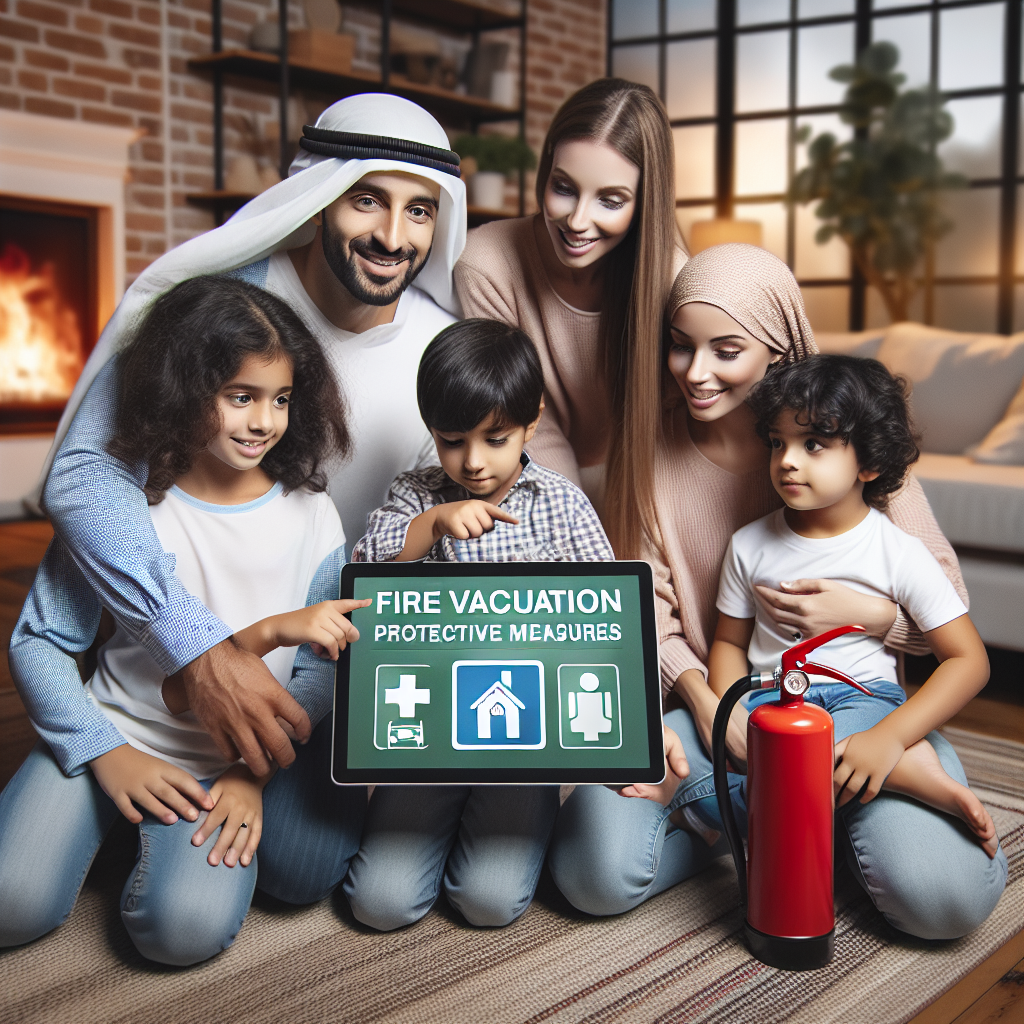In today’s fast-paced world, ensuring the safety of our loved ones has become more important than ever. From home security to online safety, there are a myriad of protective measures that families can take to safeguard themselves against potential dangers. This article explores some key strategies and tips for creating a safe environment for your family. Whether it’s installing a reliable alarm system, teaching children about stranger danger, or setting internet usage guidelines, there are numerous ways to protect your family from harm. Join us as we delve into the world of family safety protective measures and learn how to keep your loved ones safe and secure.
Importance of Family Safety

Understanding the Risks
Identifying potential safety hazards in and around the home
When it comes to family safety, one of the first steps is to identify potential safety hazards that exist in and around the home. These hazards can vary from sharp objects within reach of children to slippery floors that may cause falls. By conducting a thorough assessment of the living space, caregivers can pinpoint areas that pose risks to family members, especially children and the elderly. Common safety hazards to look out for include unsecured windows, loose electrical cords, toxic household cleaners, and unsteady furniture.
Recognizing the importance of proactive safety measures
Understanding the risks associated with these safety hazards underscores the importance of implementing proactive safety measures. Rather than waiting for accidents to happen, taking preventive actions can significantly reduce the likelihood of injuries or emergencies occurring within the household. This proactive approach involves installing safety gates at the top and bottom of stairs, securing heavy furniture to walls to prevent tipping, keeping small objects out of reach of young children to prevent choking, and ensuring that smoke detectors are installed and regularly tested. By recognizing the potential risks and being proactive in addressing them, families can create a safer environment for all members to thrive in.
Impact on Overall Well-being
f Family Safety
Neglecting family safety can have far-reaching repercussions that can deeply affect the overall well-being of every member of the household. It is crucial to understand that safety within the family unit is not just about physical protection but also about emotional and psychological security.
- Physical Well-being
- Inadequate safety measures can lead to accidents and injuries within the home, jeopardizing the physical health of family members. For instance, not having proper childproofing in place can result in young children accessing harmful substances or falling down stairs.
-
Poor safety practices such as ignoring fire hazards or not securing heavy furniture can increase the risk of household accidents, potentially causing serious harm or even fatalities.
-
Emotional Well-being
- Living in an environment where safety is not prioritized can create a constant state of anxiety and stress for family members. Children, in particular, may experience heightened levels of fear and insecurity if they do not feel protected and secure in their own home.
-
The emotional toll of living in an unsafe environment can lead to strained relationships, decreased communication, and a general sense of unease within the family unit. This can impact mental health and overall emotional well-being.
-
Psychological Well-being
- Studies have shown that a lack of safety within the family can contribute to long-term psychological issues such as anxiety disorders, post-traumatic stress disorder (PTSD), and depression. Traumatic events resulting from safety negligence can have lasting effects on mental health.
- Feeling unsafe in one’s own home can erode feelings of trust, stability, and comfort, which are essential for maintaining good psychological well-being. Family members may experience a sense of vulnerability and helplessness if safety measures are not adequately addressed.
By recognizing the profound impact that family safety has on physical, emotional, and psychological well-being, households can take proactive steps to implement comprehensive safety measures that promote a secure and nurturing environment for all members.

Securing the Home Environment
Installing Reliable Home Security Systems
When it comes to ensuring the safety of your family, installing reliable home security systems plays a crucial role in providing peace of mind and protection. Here are some key points to consider when installing such systems:
- Importance of alarm systems, cameras, and access control:
- Alarm systems serve as a first line of defense by alerting residents and authorities of potential threats or intrusions.
- Surveillance cameras provide real-time monitoring of activities in and around the home, deterring potential burglars and helping to identify suspects in case of a break-in.
-
Access control systems, such as smart locks or keyless entry systems, offer enhanced security by allowing homeowners to control who has access to their property.
-
Choosing the right security system for your household needs:
- Conduct a thorough assessment of your home’s layout, vulnerabilities, and security requirements before selecting a security system.
- Consider factors such as the size of your property, the number of entry points, and whether you have pets or children that may trigger false alarms.
- Consult with security experts to determine the most suitable combination of alarm systems, cameras, and access control features to meet your specific needs and budget.
By investing in reliable home security systems and customizing them to align with your family’s safety requirements, you can significantly enhance the overall security of your home and create a safer living environment for your loved ones.
Reinforcing Entry Points
-
Strengthening doors and windows with quality locks: It is crucial to invest in sturdy locks for all entry points in the home, including doors and windows. Deadbolt locks, for example, provide an extra layer of security compared to standard locks. Additionally, consider installing locks that are pick-resistant and tamper-proof to deter potential intruders. Regularly inspect the condition of locks and replace any that show signs of wear or damage to maintain optimal security.
-
Utilizing smart technology for enhanced security: Embracing smart home security systems can significantly bolster the protection of entry points. Smart locks offer features such as remote locking/unlocking capabilities, activity logs, and integration with other smart devices for a comprehensive security setup. Pairing smart locks with cameras and motion sensors can provide real-time monitoring and alerts, allowing homeowners to respond promptly to any suspicious activity. Ensure that all smart devices are regularly updated with the latest software to address potential vulnerabilities and maintain their effectiveness in safeguarding entry points.
Creating Safety Protocols
Developing Emergency Plans
In creating safety protocols for the family, establishing comprehensive emergency plans is crucial to ensure preparedness for various unforeseen situations. These plans should encompass protocols for responding to fire incidents, medical emergencies, and natural disasters, allowing all family members to act swiftly and efficiently in times of crisis.
-
Fire Emergency Plan: Develop a detailed fire evacuation plan that includes designated escape routes, meeting points outside the home, and responsibilities for each family member. Practice fire drills regularly to ensure everyone knows what to do in case of a fire.
-
Medical Emergency Plan: Compile a list of emergency contacts, including local hospitals, doctors, and poison control centers. Ensure all family members are familiar with basic first aid procedures and have access to essential medical supplies. Establish clear communication protocols for contacting emergency services.
-
Natural Disaster Plan: Research common natural disasters in your area, such as earthquakes, hurricanes, or tornadoes, and create a corresponding emergency plan. Identify safe locations within the home for different types of disasters and establish procedures for sheltering in place or evacuating if necessary. Regularly review and update the plan to account for any changes in the family’s circumstances or the environment.
Implementing Child Safety Measures
Implementing child safety measures is crucial in ensuring the well-being of children within the household. By taking proactive steps to childproof the home and educate children on safety protocols, parents can create a secure environment for their little ones. Here are some specific ways to implement child safety measures effectively:
-
Childproofing the home with safety gates, cabinet locks, and outlet covers:
Childproofing the home involves installing safety gates at the top and bottom of staircases to prevent falls, using cabinet locks to keep harmful substances out of reach, and placing outlet covers to prevent electrical accidents. These simple yet effective measures can significantly reduce the risk of accidents and injuries in the home. -
Educating children on emergency procedures and safety guidelines:
It is essential to educate children on what to do in case of emergencies, such as fires, natural disasters, or medical emergencies. Parents should create a family emergency plan that includes escape routes, meeting points, and important contact numbers. Teaching children how to dial emergency services and basic first aid skills can empower them to respond effectively in times of crisis. Regularly reviewing and practicing emergency procedures can help ensure that children are prepared and know how to stay safe in various situations.
Promoting Online Safety
Setting Digital Boundaries
In the realm of family safety protective measures, setting digital boundaries is paramount to safeguarding children’s online experiences. This proactive approach involves implementing specific strategies to regulate and monitor their internet usage effectively.
Monitoring children’s online activities and screen time
One crucial aspect of setting digital boundaries is monitoring children’s online activities meticulously. Parents should stay vigilant about the websites their children visit, the content they engage with, and the people they interact with online. Regularly checking browsing history and discussing online encounters can provide insights into potential risks and help address any concerning behavior promptly.
Installing parental control software to restrict access to inappropriate content
Another essential component of establishing digital boundaries is utilizing parental control software to limit access to inappropriate content. These tools allow parents to block certain websites, filter out explicit material, and set time restrictions on device usage. By leveraging such technology, parents can create a safer online environment for their children and mitigate exposure to harmful content.
Educating Family Members
Promoting Online Safety
In the digital age, educating family members about online safety is crucial to protect them from potential risks and threats lurking on the internet. This proactive approach involves instilling a sense of responsibility and awareness regarding online behaviors. Here are some key points to consider when educating family members:
-
Teaching safe internet practices: It is essential to teach family members about the importance of creating strong, unique passwords for each online account to prevent hacking and identity theft. Emphasize the significance of not sharing personal information such as addresses, phone numbers, or financial details with strangers online.
-
Importance of privacy: Educate family members about the concept of privacy settings on social media platforms and other online accounts. Encourage them to regularly review and adjust these settings to control who can access their personal information and posts. Highlight the risks associated with oversharing and the potential consequences of sharing sensitive information online.
-
Open communication: Foster an environment of open communication within the family regarding online experiences and potential risks. Encourage family members to share any concerning encounters or suspicious activities they come across while browsing the internet. Establishing trust and transparency can help address issues promptly and collaboratively.
By proactively educating family members about safe internet practices, the importance of privacy, and promoting open communication, households can create a safer online environment for everyone.
Enhancing Personal Safety
Practicing Situational Awareness
Enhancing Personal Safety
Situational awareness is a critical skill that can significantly enhance personal safety for individuals and families in various environments. By being alert and observant in public spaces, family members can proactively identify potential risks and take necessary precautions to avoid dangerous situations. Here are some key strategies to implement when practicing situational awareness:
-
Teaching family members to be alert: Encourage family members to stay attentive to their surroundings at all times, whether they are walking in a crowded area, using public transportation, or even just running errands. Being aware of who is around them and any unusual behavior can help them stay safe.
-
Observing surroundings: Instruct family members to actively scan their environment for any potential threats or hazards. This includes paying attention to exits, noticing any individuals acting suspiciously, and being mindful of any sudden changes in their surroundings.
-
Recognizing warning signs: Discuss with your family the importance of recognizing warning signs that may indicate a dangerous situation. This could include someone following them, being approached by a stranger asking for personal information, or feeling uncomfortable in a particular setting. Encourage them to trust their instincts and take action if they feel unsafe.
By instilling the practice of situational awareness within your family, you empower them to take proactive steps towards their own safety and well-being in various situations.
Self-Defense Training

Self-defense training is a proactive approach to enhancing personal safety within the family unit. By considering self-defense classes for all family members, individuals can acquire valuable skills to protect themselves in various situations. These classes empower participants with basic self-defense techniques that can be utilized in case of emergencies. Through hands-on practice and guidance from trained instructors, family members can learn how to defend themselves effectively and confidently. Learning how to assess potential threats, de-escalate confrontations, and respond appropriately can significantly increase overall safety and security within the family.
Continuous Evaluation and Improvement
Regular Safety Assessments
Continuous Evaluation and Improvement
Regular safety assessments are a critical aspect of maintaining a secure home environment for the family. These assessments involve a thorough examination of potential hazards and vulnerabilities within the household. By conducting these evaluations on a consistent basis, families can proactively identify and address safety concerns before they escalate into more significant issues. Here are some key points to consider when conducting regular safety assessments:
-
Identifying Potential Risks: Begin by identifying potential risks within the home environment. This may include hazards such as loose electrical wiring, slippery floors, or malfunctioning smoke detectors. By systematically inspecting each area of the home, families can pinpoint areas that require attention to enhance overall safety.
-
Assessing Security Measures: Evaluate the effectiveness of existing security measures, such as locks on doors and windows, alarms, and outdoor lighting. Ensure that these systems are functioning correctly and are up to date with the latest technology to provide optimal protection against intruders or emergencies.
-
Involving Family Members: Encourage all family members to participate in safety assessments to raise awareness and promote a collective responsibility for maintaining a secure environment. By involving everyone in the process, individuals can contribute valuable insights and perspectives on potential safety concerns that may have been overlooked.
-
Creating an Action Plan: Based on the findings of the safety assessment, develop an action plan to address identified risks and vulnerabilities. Prioritize tasks based on urgency and feasibility, and establish a timeline for implementing necessary safety improvements. Regularly review and update this action plan to reflect any changes in the household or external factors that may impact safety.
Regular safety assessments play a crucial role in safeguarding the well-being of the family and creating a secure living environment. By staying vigilant and proactive in identifying and addressing safety concerns, families can mitigate risks and enhance overall protection within the home.
Seeking Professional Guidance
Seeking professional guidance is a crucial step in ensuring the safety of your family. By consulting with security experts, families can receive personalized safety recommendations tailored to their specific needs and circumstances. These experts have the knowledge and experience to assess potential risks and vulnerabilities in the home environment, offering valuable insights on how to address them effectively.
Benefits of Seeking Professional Guidance:
– Customized Safety Recommendations: Security experts can conduct thorough assessments and provide tailored safety solutions that suit the unique requirements of each family.
– Expertise in Security Technologies: Professionals stay abreast of the latest safety technologies and practices, ensuring that families receive recommendations based on the most current industry standards.
– Risk Assessment: Security experts can identify potential security threats and vulnerabilities that may not be apparent to the average homeowner, helping families proactively mitigate risks.
– Peace of Mind: By seeking professional guidance, families can feel more confident in their safety measures, knowing that they have received expert advice on protecting their loved ones.
FAQs – Family Safety Protective Measures
What are some basic family safety measures that should be implemented at home?
Basic family safety measures that should be implemented at home include installing smoke alarms on every floor, keeping all hazardous chemicals and medications locked away from children, securing furniture to prevent tip-overs, childproofing electrical outlets, and practicing fire escape drills regularly.
How can families protect themselves from home invasions or burglaries?
Families can protect themselves from home invasions or burglaries by installing quality locks on doors and windows, using a security system with cameras and alarms, keeping valuables out of sight, not sharing personal information on social media, and getting to know their neighbors and community.
What steps can families take to ensure the safety of their children online?
Families can ensure the safety of their children online by setting parental controls on devices, monitoring their internet usage, educating them about online safety and the dangers of sharing personal information, encouraging open communication about their online experiences, and setting boundaries for screen time.
How can families stay safe during natural disasters or emergencies?
Families can stay safe during natural disasters or emergencies by creating an emergency plan that includes evacuation routes, meeting points, and emergency contacts, stocking up on supplies like food, water, and first aid kits, staying informed about weather alerts and emergency notifications, and practicing drills for various scenarios.